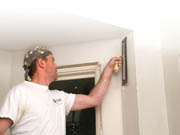Bear in mind that no one system meets every criterion for construction. Conventional plaster, for example, creates beautiful walls but may be too costly to meet many construction budgets. Drywall, on the other hand, is economical but provides only minimal hardness and a less monolithic finished appearance. While some veneers create hard surfaces, others are prized for their workability.
Making the right choice among systems begins by setting priorities. What's most important to your job? Installed cost? Life-cycle cost? Workability? Surface hardness? Appearance? Sometimes, a job may call for considering and weighing multiple factors. For example, controlling costs may be important but an improvement in the look of its walls and ceilings can enhance a building's marketability.
"Architects are increasingly specifying plaster systems for use in buildings because of their dramatic appearance and long-lasting qualities," says Kevin Moyer, U.S. Gypsum Company's business line manager, superior wall finishes. "Builders of large, custom homes are also converting many of their wall systems to veneer plaster systems as an upgrade to typical drywall construction. Veneer plaster systems provide aesthetics, surface hardness and a superior appearance that is worth the investment."
Creating a decorative finish is another reason to incorporate veneer plaster systems. Walls are turned into statements of color and texture when these systems are used over other, more standard finishing options, such as drywall. They are easily blended on-site and permit the applicator to impart a more personalized expression.

Good, better, best
As with most construction materials, there are good, better and best levels in terms of aesthetics and performance. Using a simple ranking system (with No. 1 being the best), this is how U.S. Gypsum ranks various types of wall systems in terms of performance and surface appearance.No. 1: Conventional full-thickness plaster systems. These represent the best of the best in construction and provide the ultimate interior finish. Conventional plaster systems are abuse-resistant and offer a supremely monolithic surface. In addition, they can be finished smooth or textured and provide long-term performance and beauty.
Because conventional plasters can be expensive, high-use public buildings such as hospitals, schools and other institutional facilities, are typically the most common types of projects that benefit from plaster's long-term performance, low maintenance and strong aesthetics.
No. 2: Two-coat veneers. If a high-quality conventional plaster look is desired but economics is important, a two-coat veneer system makes sense. On the most basic level, two-coat veneer plasters are composed of a veneer plaster baseboard (commonly known as "blueboard"), a 1/16- to 3/32-inch-thick basecoat and a veneer finishing material. Several veneer finishes are available for two-coat systems, all of which provide a monolithic surface with good-to-excellent wear resistance.
High-strength veneer plasters make sense when abuse-resistance is a priority.
High-strength veneer plasters make sense when abuse-resistance is a priority. USG's Imperial Brand Finish Plaster, for example, features remarkable hardness. It might find it on walls and ceilings at museums and other public buildings that must withstand decades of abuse from visitors.
No. 3: One-coat, veneer plaster systems. If the goal is to upgrade from a drywall system and surface hardness is a priority, a one-coat high-strength veneer is the best choice. High-strength veneer plaster finishes offer up to 100 times the abrasion resistance of drywall and a four-fold increase in indentation resistance. These systems represent an outstanding growth opportunity for a wide variety of applications.
Because these finishes can create smooth or textured surfaces, they are ready for finishing in as little as 24 hours when drying conditions are favorable. Builders can complete construction three to four days sooner by using one-coat veneer plaster systems compared to waiting for drywall drying cycles. The single-coat's shorter construction time also brings in tenants faster, which in turn, reduces interest payments on construction loans.
No. 4: Gypsum drywall. When gypsum drywall systems appeared in the early '40s, low cost and speed of application were the dominant factors. Especially in residential construction, surface hardness and a truly monolithic appearance became less important in achieving marketability.
Today, drywall systems technology has advanced to the point where the product provides a relatively smooth, serviceable finish at the lowest possible initial installed cost. Drywall still offers an acceptable means of interior finishing at the most economical level.

Solid past, bright future
Those with long tenure in the plastering field do not hesitate to predict continued growth-and excitement-over the use of high-end plaster systems."I have no doubt that the quality and distinctive look of plasters will fuel continued growth," says Kevin Malee, owner and president of Chicago's AAA Plastering, which was founded about 20 years ago and currently employs four two-man crews full time. "People tell me that they can see and ‘feel' the quality of a plaster project vs. a more conventional wallboard."
Malee, whose own history with plaster began in the early '60s, has seen its usage increase sharply in many expensive residences.
"We do a lot of top-end homes that feature exotic staircases, specialty moldings and cornices, ceiling and wall coffers, canopies and other specialty shapes and textures that simply can't be made from any other readily available material," adds Malee.
Large contractors are also seeing a shift in their primary areas of growth.
"I would say that 15 to 20 years ago, residential construction comprised about five percent of our business," says Mike Pilolla, president of J.P. Phillips Inc., of Franklin Park, Ill. "Now, about half of our projects are performed in extremely high-end homes."
Pilolla, who has been in the plaster business since 1980 and has a staff of 120 tradesmen at Phillips.
"Architects and owners alike seem to be intrigued and delighted with the almost unlimited variety of cornices, moldings and coffers that are available now, almost on demand," notes Pilolla. "These can be drawn up, literally, in one day and fabricated and installed within a few days."
Pilolla observes that his business is applying more veneer plaster systems and sees the trend growing for the material.
Malee views the trend as a movement away from "canned" appearances to a more customized look. AAA Plastering also works extensively with interior and exterior stucco and limestone products.
As the movement tracks toward high-end construction and more sophisticated veneer systems, is the skilled workforce prepared to handle it?
"Absolutely," says Steve Nelms, the 19-year veteran director of plaster programs for the Bricklayers and Allied Craft Workers Union in Chicago. "We cover all phases of plaster training here, from exteriors to mould making to conventional and veneer systems. We are seeing a resurgence in training high-end plasterers to apply sophisticated systems safely and with great skill."
The District Council Training Center, just outside Chicago, trains about 300 tradesmen a year, according to Nelms, with an upswing in attendance "during the past four years or so. It would equate the growth of plaster usage in high-end construction with the housing boom itself. The trend toward customized construction is good for those in the specialty plaster business."
This boom has produced some enormous plaster projects in the Chicago area, including a gargantuan home in the northern suburbs.
"There will always be a place of distinction in commercial and residential construction for plaster materials," says Moyer. "The challenge is to provide the right information to designers, builders and homeowners to ensure that they can make an educated choice. To meet this challenge, USG intends to passionately extol the benefits of our plaster systems."
Like a classic song or centuries-old painting, some things never really get old. Such is the case with traditional and specialty plaster walls and ceilings.
